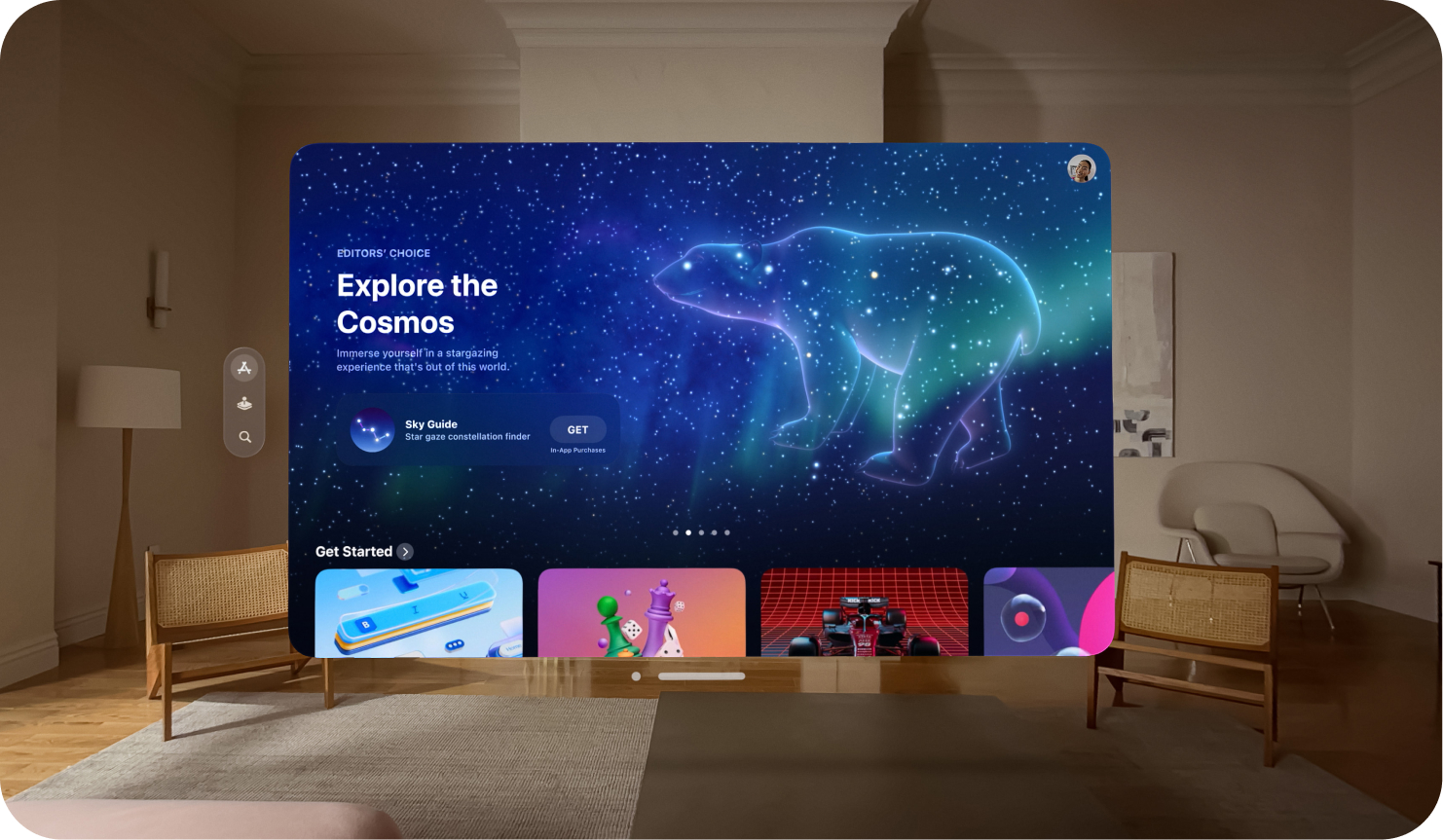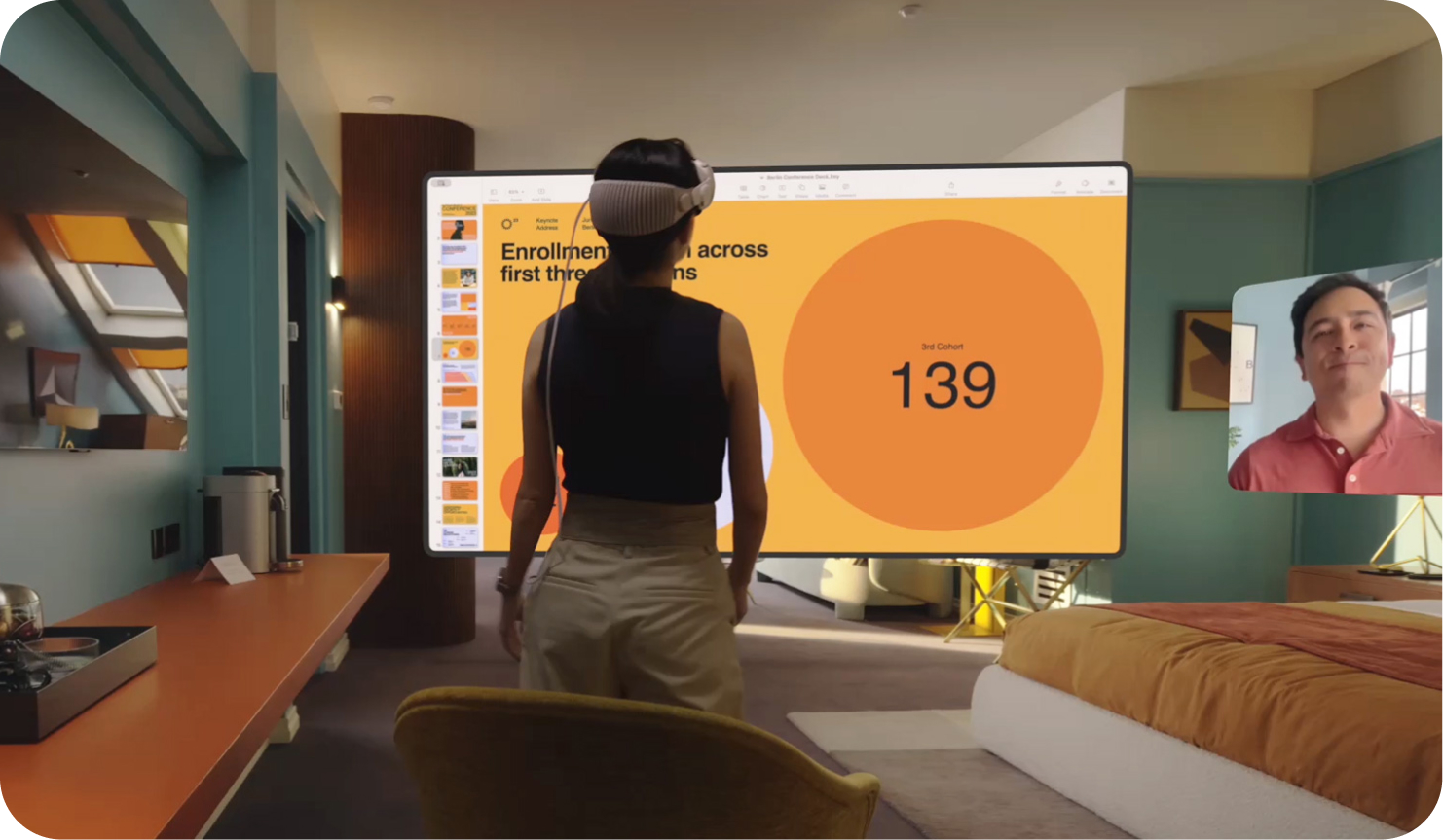The world watched as Apple unveiled the Vision Pro, a dramatic evolution of XR hardware and a new spatial computing platform.
Similar to how smartphones rewrote the definition of mobile, Vision Pro’s ripple effect across technology, business, and society has yet to be completely imagined, let alone taken effect. Like the smartphone, which took apps out of tethered computing environments into the palm of everyone’s hand, we expect that immersive devices and advancements in spatial computing will rewrite the rules for the ways we work, live, play, and communicate in the future. As designers and futurists, we have been immersed in spatial computing in its current form and have recognized its nascent importance beyond gaming or digital worlds.
Spatial Computing
The New Paradigm
On the surface the VisionPro appears as another oversized XR headset still searching for a human-centered reason for being. One is still left wondering – why would people need this? Perhaps a technology in search of a problem to solve. But, below the surface we believe the VisionPro’s positioning as a spatial computing platform astutely signals a significant paradigm shift underway. One that ultimately will be driven by the human need to remove barriers and more seamlessly connect and converge our work, life, and communities across spaces – digital and physical. Although Apple has now introduced spatial computing to the consumer vernacular, the shift to spatial computing has been in progress for sometime. Spatial computing is more present in our daily lives than we may realize. Voice commands control our automated homes, entertainment apps share virtual experiences across digital and physical boundaries, and even many applications in business, transportation, medicine, wellness, fitness, and finance are integrating spatial computing elements. As spatial computing becomes more intelligent with integrated AI, we expect to see innovation in just about every other “space” that people occupy.
Our First Takes
Progress & Opportunity
We have been working with companies to prepare for this spatial computing paradigm shift over the past few years as we envision and design more immersive product experiences. We describe immersive experiences as being – spatial, sensory and social. Each requires a shift in mindset and expertise to create the digital experiences of tomorrow. Apple’s platform embraces each of these characteristics, and bypasses many of the past challenges to innovation in each of these areas. But in many ways, it is just the start, laying the groundwork for even more valuable innovation and critical refinement to enhance machine-to-human partnerships. We are impressed with many features of Apple’s new platform and are already exploring how these new modalities will affect design and product innovation. Here’s our take.

Image: Apple
1 | More Spatial
Mixing Reality Instead of Binary
Apple is bucking the trend of full virtual, metaverse/VR experiences and embracing a more blended augmented reality approach that aligns with our more realistic view on the next stage of digital-physical immersion. Binary modes feel less realistic in most use cases. People need and want seamless, flexible movement between digital physical boundaries, over virtual isolation. The metaverse promise of fully virtual environments has never felt aligned to the reality of the natural progression in spatial computing experiences. Apple addresses this with a variety of mixed reality features such as the personal immersion dial on the VisionPro, allowing the user to adjust the degree of immersion or occlusion from the world. This innovation recognizes reality, and will be interesting to watch as users adopt it.
Familiar Metaphors, Less Novel
From a spatial design perspective, the use cases demonstrated by Apple aren’t ground-breaking. They mostly reflect flat computing windows overlaid in physical spaces and lack uniquely different applications. While the concept of spatial computing is novel, Apple’s actual interface metaphors are not. Perhaps, the focus is on familiar interfaces and less specific use cases to empower developers in activating the potential of the platform and build a bridge to ease consumer adoption. If experiences were too novel or specific it could slow growth of the platform. Successful innovations often build a bridge of familiarity to aid in the transition to new paradigms.
From Screens to Scenes in Immersive Environments
Disney’s partnership with Apple indicates the power this platform has to transform storytelling and engagement. In 2-D realities, computing users only have one point of view or perspective. In 3-D contexts, 360 degree content is experienced rather than simply watched. With Apple’s immersive environments and 3-dimensional camera we can imagine personal immersive experiences that allow people to participate in stories, adventures, performances, and gaming in new and provocative ways. It’s a shift in design from screens to scenes, as we write about in our recent article.

Image: Apple
2 | More Sensory
No Controllers, Effortless Control
Eliminating awkward accessories and controllers in lieu of natural sensory controls demonstrates the elegance of using human gestures and behaviors to control technology. While the lack of haptics is a trade-off, the loss of controllers combined with Vision Pro’s use of hand, face, and eye gestures will dramatically improve natural interactions. Beyond that, more natural, immersive experiences across many applications will accelerate adoption and open the door to more valuable experiences. We can imagine limitless possibilities for controller-free interfaces that will rapidly improve mobility, collaboration, digital medicine, scientific research, and customer care. Eye movement, facial and hand gestures, voice, and facial recognition are all just the beginning.
Intelligent Senses Intuit Naturally
Up to now, people have had to learn how to use technology, but in this new conscious era technology needs to learn how to relate better to humans. Apple’s eyesight and gesture recognition rely on advanced sensory intelligence to create more intuitive ways to discern human movement and intent. AI and spatial computing are natural companion technologies that, in combination, will accelerate innovation. Truly personalized, intelligent, immersive experiences will naturally offer new modalities of interaction to create new outcomes. Applications will not only feel more natural, but they’ll also learn and adopt interaction styles and preferences that suit individuals. The combination of Apple’s Vision Pro and AI is a wildly powerful combination of technologies that will break boundaries and power new ideas.

Image: Apple
3 | More Social
Socially Aware, but Singularly Focused
Apple social awareness features attempt to reduce the siloed nature of common VR experiences that isolate people from the real, physical world. Features that blur the digital/physical boundary, such as front-facing glass and automatic features that bring external objects and people into view while wearing the headset, are examples of how users can use the device without being completely removed from their world. Despite steps forward in social awareness, most of Apple’s use cases and value props centered around solo time at home or work which may limit its utility. We believe the role of immersive is ultimately to enrich more human connections, as we share in our FutureView 2023 report . We hope to see Apple and its development community tap into more socially driven use cases in the future.
New Dimension in Spatial Communication
Video conferencing is about to leap out of 2D into 3D. Apple’s 3D FaceTime features including digital personas, spatial audio and integrated shareplay, are bringing the physical to digital, not just digital to physical. This dramatic blending of realities, more so than any past device, will enable people to talk, play, interact, and work together naturally across digital spaces. Say goodbye to flat, 2D digital backgrounds. The ability to bring people together to share experiences, regardless of location, can be a force for unification, communication, and collaboration at new levels.
Embracing Spatial Design
Apple Vision Pro just rewrote the rules – far beyond XR and gaming. Apple introduced a new computing paradigm that is already fueling disruption across virtually every application category. While we’re impressed with Apple’s device experience design, sensors, controls, and capabilities, we are most impressed with the larger implications of this platform on a more seamlessly blended physical/digital world.
While we don’t see a near-term future where people wear XR goggles in their regular daily activities, but, we do think that spatial computing is ripe for rapid innovation. With the delivery of Apple’s platform months away, and broad adoption even further out, we recommend that companies explore ways to incorporate spatial computing into their product strategies now. This evolution will rapidly accelerate, exemplified by brilliant advancements like the one that Apple has made. Apple has fixed a new goal on the horizon where digital/physical interactions are not switched on or off but rather lived naturally. And, this is just the beginning.
A Punchcut Perspective
Ken Olewiler, Jay Jansen
© Punchcut LLC, All rights reserved.



